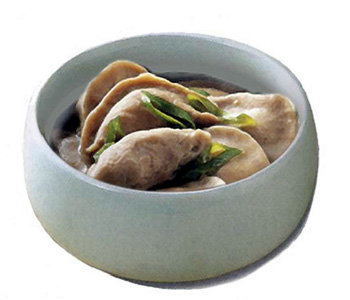Special dumpling enjoyed by king despite severe illness
Special dumpling enjoyed by king despite severe illness
Posted July. 13, 2015 07:20,

Hwangjagyehondon (special recipe for an elderly sick person) that royal doctor Lee Shi-pil served King Sukjong.
King Sukjong (1661-1720), the 19th king of the Joseon Dynasty, started suffering from stomach satiety at age 53. With his belly gradually getting bigger, he could not eat food properly, which brought all people involved in keeping the kings health to a state of emergency. There was one recipe that King Sukjong enjoyed several times despite his illness: Hwangjagyehondon that was served by royal doctor Lee Shi-pil (1657-1724).
Hwangjagyehondon is introduced as food cure for an elderly person who cannot eat properly due to stomach disorder in Uihak-ipmun (Introduction to Medicine) written by Lee Cheon of the Ming Dynasty in China. "Hondon" refers to a type of dumpling whose skin is as thin as a sheet of paper, and is the size of chestnut.
This recipe is prepared by boiling lean meat of Hwangjagye (hen with yellow feather) together with green onion in the kettle. Then, thin skin is prepared with flour, and filling is prepared by mixing thinly minced meat with soybean sauce and akane powder. Then, filling is wrapped with the skin to be made into dumplings, before these are boiled. If one eats this dumpling when the stomach is empty once daily, it helps warm up the intestinal organs, and causes the face to look greasy and healthy.
Hwangjagyehondon that was served to King Sukjong by Lee Shi-pil was prepared in a slightly different manner. Firstly, filling that will be put in hondon is prepared. Lean meat from two yellow-feathered hens and one pheasant, button mushroom, green onion, and garlic are minced, and fried in oil mixed with soybean sauce. Then, this gets smashed with the ladle to prevent it from being clotted, before being seasoned with seasonings. The skin is prepared with buckwheat powder in lieu of flour, which was rare at that time. Buckwheat powder is filtered with fine sift, and made into paste by adding water, and then the paste is flattened with a roller into the form of a thin sheet of paper. The skin is made into small sizes by using bamboo. Then, filling is wrapped with this skin to be made into dumplings, which are parboiled in boiling meat soup, before being placed in a bowl. Then, one can eat the dumpling by dipping it in meat soup that is seasoned with vinegar, soybean sauce, green onion, and garlic.
Hwangjagyehondon would have been tasty to King Ukjong, who had lost appetite, because it offered harmonious taste of chicken and pheasant meat and button mushroom, and was easy to eat due to its small size.
The person who first prepared the recipe was Kwon Ta-seok, who was a warehouse guard at Gangwon, rather than Lee Shi-pil. Saongwon was the department in charge of supplying foods for the royal family. Kwon Ta-seok was not a chef for the royal kitchen, but was good at cooking nevertheless, and Sook Soo, Neok Soi and Park I-dol, who became royal kitchen chefs at Lee Shi-pils recommendation, learned the recipe from Kwon.
"Seungjeongwon Ilgi (diary)" suggests a story, saying King Sukjong said he wished to eat Hwangjagyehondon on September 12, 1719, one year before his death. At that time, Lee was in exile from March 22, 1718, after he returned empty-handed from China, which he visited in 1717 to find medicine to cure the kings eye disease. Hwangjagyehondon, which was served to King Sukjong when he expressed his wish to eat the recipe, would have been prepared by Neok Soi and Park I-dol, who had learned the recipe from Kwon Ta-seok.
Lee learned the kings death in Bukcheong, the place where he was in exile. King Sukjong passed away with ascetic fluid in his belly on June 8, 1720, when he was 59. After his release from exile, Lee Shi-pil compiled to a book the best recipes that were said to be healthy for elderly people from among Chinese and Japanese foods as well as Korean. This is the book Somunsaseol Shikchibang (food cure recipes from rumor stories). The recipe of Hwangjagyehondon developed by Kwon Ta-seok can also be found in this book.







